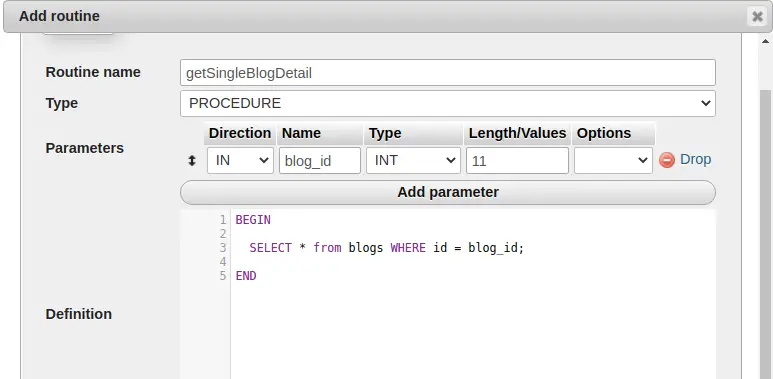
This function takes two input parameters: the cost and the price of something. Let's create a function named calcProfit. Now that we have a database and a table to work with, we are ready to create a stored function. The following SQL statement adds some sample data to the products table: INSERT INTO products (prod_name, prod_cost, prod_price) VALUES ('Basic Widget',5.95,8.35),('Micro Widget',0.95,1.35),('Mega Widget',99.95,140.00) Creating the stored function To do this, run the following SQL statement: CREATE TABLE products (prod_id INT NOT NULL AUTO_INCREMENT, prod_name VARCHAR(20) NOT NULL, prod_cost FLOAT NOT NULL DEFAULT 0.0, prod_price FLOAT NOT NULL DEFAULT 0.0, PRIMARY KEY(prod_id)) Next, create a table in the username_test database named products. Otherwise, if you are using the mysql command-line program, type the following SQL statement: USE username_test If you are using phpMyAdmin, click the name username_test to select the database. Not as part of the application's core transactional work.You can run the previous SQL command (and the following SQL commands) from the command line using the MySQL tool, or in your web browser using phpMyAdmin.
#Mysql stored procedure code#
Their application code was in fact waiting most of the time for elaborate stored procedures to run, and they were limited on their ability to scale up because there's a finite amount of computing horsepower on the database server.įor these reasons, I hardly ever use stored procedures, except for infrequent administrative tasks. Their PHP application servers were nearly idle, whereas the CPU was overloaded on the database server. I consulted for a site whose developers were PHP experts, but they struggled with coding and debugging and optimizing MySQL stored procedures. If you need to scale out the database by sharding, it's not easy to make stored procedures query any shard besides the one they are running on. It's not possible to scale out if a lot of your business logic is in stored routines.

You can scale out application code more easily than a database server, or even push logic out to clients (i.e. Modern application architecture relies on scaling out to multiple servers as much as possible.

Stored routines run on the database server, not on application servers. They undoubtedly are less productive with the unfamiliar MySQL stored routine language. There is reference documentation only.ĭisadvantages that may not be limited to MySQL (may apply to other brands just as much):ĭevelopers on your team are probably very productive with their primary programming language, e.g.
#Mysql stored procedure manual#
No official task-oriented manual for developing stored routines.No standard library provided of procedures and functions that comprise an application framework.If more than 256 routines are used in a given thread, all 256 are discarded and must be recompiled. If a routine is modified, the compiled version is discarded in all threads and must be recompiled. Compiled routines are not shared between threads.

Stored routines are compiled just-in-time by each thread that uses them. Some developer tools attempt to mimic a debugger by inserting debug logging statements within the body of the stored routine. MySQL stored procedures have a lot of disadvantages compared to other implementations: Stored procedures are not as mature in MySQL as they are in commercial databases. However, it's not as common in the MySQL community. Oracle or Microsoft SQL Server) to develop a robust set of stored procedures as a data layer for your application. It is common in other brands of SQL database (e.g. However, I will try to give an answer that is based in facts. This is bound to be a subjective question, and answers will tend to be opinion-based, which is more or less discouraged by the site's guidelines.


 0 kommentar(er)
0 kommentar(er)
